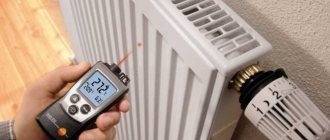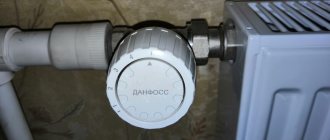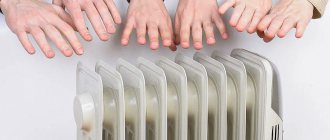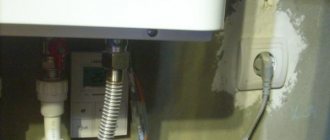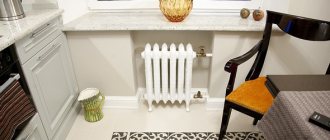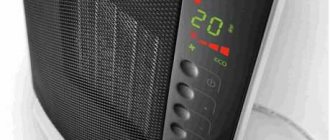The presence of optimal warmth in living rooms guarantees its residents a healthy lifestyle, a cheerful state and a good mood. Caring for the health of our loved ones forces us to pay attention to the temperature range of the apartment. And although each of us has distinctive subjective preferences about the microclimate, knowledge of the recommended standards for different rooms will help to understand how favorable the living conditions are.
Temperature standards in the apartment
Temperature standards in residential premises are strictly regulated by GOST R 51617-2014, GOST R 51617-2014, R 51617-2000. According to this document, minimum values are established in residential and other premises of houses:
- In living rooms and kitchens - not lower than 18 degrees Celsius
- In the bathroom - at least 25 degrees
- In a separate toilet - 18 degrees
- In the elevator of a residential building - not lower than 5 degrees
- In the attic and basement non-residential premises - 4 degrees
Standards in residential premises are established for the comfort and health of citizens, since these conditions allow residents to remain healthy and avoid colds. Standards in non-residential premises are related to the technical operation of various equipment.
In 2022, SANPins also introduced an expanded standard for residential premises. It includes the following conditions:
- In an ordinary living room - 18 degrees
- In the corner room - 20 degrees
- In a room not adjacent to the staircase and inter-apartment vestibule - 16 degrees
Important! Gost and SNIPs set lower values, but there are no upper limits. That is, if there is incredible heat in the apartment, and the temperature in the rooms reaches 27-30 degrees, then there is no use in complaining.
Arbitrage practice
Judicial practice on issues of compliance with temperature conditions and heating in apartment buildings is quite extensive and contains answers to key questions, failure to comply with which will entail a refusal to satisfy the subscriber’s requirements.
For example, in the Decision of January 24, 2022 in case No. 2-278/2017, the court refused to satisfy the subscriber’s requirements for recalculation due to the fact that all the measurements taken, attached as evidence of exceeding permissible temperature standards, were compiled by the subscriber independently. Moreover, the subscriber in every possible way prevented representatives of the management organization from entering his apartment and did not allow them to take measurements.
But in the Ruling of the Supreme Arbitration Court of the Russian Federation dated April 11, 2012 No. VAS-3355/12 in case No. A03-1052/2011 on the refusal to transfer the case to the Presidium of the Supreme Arbitration Court of the Russian Federation, the court satisfied and collected from the homeowners’ association the debt for the supplied thermal energy for heating on the basis of , that the resource supply company provided documents indicating that inconsistencies in the temperature conditions in individual apartments were identified in the network, which is the operational responsibility of the homeowners association. In addition, no evidence was provided to show that there were clear reasons for the temperature deviation.
If the apartment is too cold, you need to contact utility services.
If they don’t react, then the regulatory authorities will. You may receive compensation for services of poor quality. Useful article? Rate and share with friends!
Heating time
The heating period depends on the external environment and the weather outside. The decision on heating is made by the local government, usually the municipality. This happens if the average daily outside temperature drops below 7 degrees.
In most modern houses there is another system - automatic. The temperature at the outlet of the boiler and the decision to supply hot water to the heating system are made by automation, which monitors outdoor indicators.
At the same time, the temperature of the coolant is regulated, which is convenient. This prevents residents from languishing from excessive heat at the beginning and end of the heating season.
Battery temperature
Battery temperature depends on several factors:
- The coolant or liquid leaving the boiler, which can be from 95 to 150 degrees
- Weather conditions, degree of soil freezing
- Coolant temperature at the entrance to a specific house
- Floor heights and distance of the apartment from the coolant entrance to the house.
There are no clear standards for what the coolant should be when leaving the boiler, since the temperature in the room is primarily important. Usually, in severe frosts, when leaving the boiler room, the liquid is heated to 130-150 degrees.
However, upon entering the house it cools down to 115-90 degrees. Therefore, in severe frosts, they try to heat more - that is, bring it to maximum values. At the beginning and end of the heating season, the water is heated only to 115 degrees.
In the house, all batteries are washed with coolant according to the ring principle. A residential building can be equipped with several circuits, one for each riser or entrance.
Therefore, when entering the heating circuit, the liquid has a maximum temperature. This is usually on the lower floors of buildings. At the end of the circuit, the coolant has already managed to give up all the heat to most apartments and cools down.
This explains the fact that residents of the lower floors complain about excessive heating of the room, and the upper floors cut off the call to the control room with complaints about the cold.
The heat of the radiators themselves in the apartment should be 80-90 degrees. This ensures the safety of residents when touching the batteries and the required temperature in the room. The maximum water temperature that the battery itself can withstand is 130 degrees for cast iron products and 110 degrees for other models.
Hygienic requirements for the site and territory of residential buildings when placing them
2.1. Residential buildings must be located in a residential area in accordance with the general plan of the territory, the functional zoning of the territory of the city, town and other populated areas. 2.2. The site allocated for the placement of residential buildings must: - be located outside the territory of industrial, communal, sanitary protection zones of enterprises, structures and other objects, the first zone of the sanitary protection zone of water supply sources and drinking water pipelines; — meet the requirements for the content of chemical and biological substances potentially hazardous to humans, biological and microbiological organisms in the soil, the quality of atmospheric air, the level of ionizing radiation, physical factors (noise, infrasound, vibration, electromagnetic fields) in accordance with the sanitary legislation of the Russian Federation . 2.3. The land plot allocated for the construction of a residential building must provide for the possibility of organizing a local area with clear functional zoning and placement of recreation areas, playgrounds, sports areas, utility areas, guest parking for vehicles, and green spaces. 2.4. When landscaping the local area of residential buildings, it is necessary to take into account that the distance from the walls of residential buildings to the axis of tree trunks with a crown with a diameter of up to 5 m should be at least 5 m. For larger trees, the distance should be more than 5 m, for shrubs - 1, 5 m. The height of the bushes should not exceed the lower edge of the window opening of the premises on the first floor. 2.5. There should be no transit traffic along the internal driveways of the local area. Access to waste disposal sites must be provided for special vehicles. 2.6. Distances between residential, residential and public, as well as industrial buildings should be taken in accordance with the hygienic requirements for insolation and sun protection of residential and public buildings and territories. 2.7. When placing residential buildings, it is planned to provide them with utility networks (electric lighting, drinking and hot water supply, heating and ventilation, and in gasified areas - gas supply). 2.8. On land plots, entrances and passages to each building must be provided. Places for parking or garages for cars must comply with the hygienic requirements for sanitary protection zones and the sanitary classification of enterprises, buildings and other objects.
In local areas, it is prohibited to wash cars, drain fuel and oils, or adjust sound signals, brakes and engines. 2.9. Areas in front of house entrances, driveways and pedestrian paths must have hard surfaces. When installing hard surfaces, the possibility of free drainage of melt and storm water must be provided. 2.10. In the courtyards of residential buildings it is prohibited to place any trade and public catering establishments, including tents, kiosks, stalls, mini-markets, pavilions, summer cafes, industrial facilities, small repair enterprises for cars, household appliances, shoes, as well as parking lots of public organizations. 2.11. Cleaning of the territory should be carried out daily, including in the warm season - watering the territory, in winter - de-icing measures (removal, sprinkling with sand, de-icing reagents, etc.). 2.12. The courtyard areas of residential buildings should be illuminated in the evening. Lighting standards are given in Appendix 1 to these sanitary rules.
What types of batteries are there?
The room temperature depends not only on the coolant itself, but also on the number of sections in the battery.
Cast iron products, which are rare in modern homes, have the best heat transfer. Their heat transfer is 70%. For other products: aluminum, bimetallic and steel, this figure is 50%.
The power of the battery itself is measured in watts. According to SNiP 41-01 per 1 sq. meter of area should be at least 10 watts.
The power of one battery section depends on the material:
- Cast iron – 100 W
- Aluminum – 200 W
- Bimetal – 150 W
- Steel – 120 W
Depending on these indicators, calculations are made for the installation of heating devices.
Important! If the power of the devices is clearly less than required, that is, they have a small number of sections, then it is useless to blame the utilities due to the insufficient amount of heat.
An inspection of the premises by technicians will reveal this. According to the law, responsibility for the equipment inside the apartment lies with the owner or the person who owns the apartment under a social tenancy agreement.
How to take measurements
If you have any doubts about the insufficient heat of the coolant, measurements must be taken.
They are made at several points:
- The air in the room is measured in the center of the room. The distance from the batteries must be at least 0.5 meters, from the floor - at least 0.6 meters.
- Pipes. To measure them, you need to attach a thermometer to the product at the entrance to the apartment or measure it with a beam on the pipe itself in close proximity to the pipe. It is also advisable to measure the temperature of the pipe leaving the room.
- Batteries. It is better to measure the radiator in several places, especially if there are many sections. Measurements must be taken in the first and last sections. The temperature is measured in the same way as on the pipe.
- Coolant. To measure, you need to open the tap, if available, and drain a small amount of liquid into the container. When descending into the stream, you need to place a thermometer.
Utility services are primarily responsible for the result, that is, for the temperature in the room. But measurements according to this scheme will show where the gap exists and why it is cold or hot in the apartment.
If the room temperature is lower than normal, but all technological standards are met, then a complaint should be filed with the local management organization. It is also necessary to complain if the coolant temperature is less than the required one.
Advice. It is better to measure the temperature in the batteries by residents together in different apartments. In case of obvious violation, a collective complaint has greater effect than a private one. And, conversely, if the standards are met in one apartment, but not in another, this is an indicator of a malfunction in the heating system.
Competent measurements, analysis of the operation of devices in the room and timely contact with the management organization will help you quickly and clearly understand the cause of insufficient heat and correct it.
Responsibility of utilities for violation of temperature standards
Violation of the temperature standard not only causes discomfort, but can also lead to exacerbation of a number of chronic diseases. If utility services did not check the functioning of the system in a timely manner, then residents of the house have the right to file a complaint. She initiates a review by regulatory authorities of the validity of this application.
The responsibility of utility services for violation of temperature standards comes down to the need to recalculate the cost of services already provided. Additionally, they are also required to correct all system faults. After completing the work, the microclimate of the room is re-checked. The result is recorded in a special act.
Temperature check report for residential premises
If irregularities have been identified in the central heating system, the apartment tenant has the right to claim a recalculation of the amount accrued to him in the amount of 0.15 per hour of use. Thanks to this, payments can be reduced by 90% within 28 days. However, to obtain such a decision, you will need to file a claim in court.
In practice, there are many examples of poor quality heating services for entire houses. Residents can file a class grievance that will allow them to obtain the compensation they are entitled to under the law.
To assert your rights, it is recommended to contact regulatory authorities. The application may indicate several residents at once who are not satisfied with the service provided by the utility organization. If she refuses to carry out repair work or inspection, then a lawsuit is filed.
